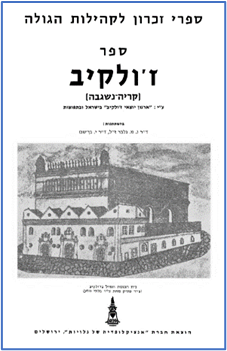
My grandfather was born in Galicia and moved to the U.S. as a young man before World War I. He changed his name and later also changed his birth date on official records. Grandpa died decades before I was born, and no one in our family knew anything about his origins, or even his birth name.
In the 1970s, after my grandmother passed away, we found among her papers a letter, handwritten in Yiddish, dated 1925. It was a note from my great grandmother in the Old Country to my grandfather in San Francisco, thanking her son for the $25 he sent her. So he was not only in touch with his family in Europe, but he had also been sending money home, unbeknownst to his American family! The letter had a name and a return address: “Rywka Basseches, Zoulier, near Lemberg, Poland.”
 We searched old maps, museums, and libraries but were unable to find a town or place called “Zoulier.” But a few decades later, the
Polish State Archive digitized old vital records and JRI-Poland
indexed and made them available online. The name “Basseches” led to my grandfather’s 1891
birth record
and started to unravel the mystery. His hometown was Zolkiew, Austria, which later became part of Poland, then the USSR, and is now
Zhovkva in the Ukraine.
We searched old maps, museums, and libraries but were unable to find a town or place called “Zoulier.” But a few decades later, the
Polish State Archive digitized old vital records and JRI-Poland
indexed and made them available online. The name “Basseches” led to my grandfather’s 1891
birth record
and started to unravel the mystery. His hometown was Zolkiew, Austria, which later became part of Poland, then the USSR, and is now
Zhovkva in the Ukraine.
Zolkiew was founded in 1603 and was home to Jews since at least 1670. By the early 20th century, Zolkiew was a thriving Jewish community, home to rabbis and scholars and a rich social and cultural scene. Zolkiew had Jewish schools, theater, a majestic synagogue built in the 1690s, Zionist youth movements, and a Jewish orphanage. Approximately 5,000 Jews constituted about a third of the town’s population and the backbone of its commerce and printing industry.
This vibrant shtetl came to a tragic end during the Holocaust. The Nazis occupied the city on June 28, 1941, burned down the old synagogue, and destroyed the Jewish cemetery. In March 1942 and again in November, hundreds of Jews were sent by cattle cars to the Belzec extermination camp. A Jewish ghetto, established in December 1942 was liquidated, in March 1943. Many survivors from the ghetto were taken to the Burk Forest, outside town, and shot. Of a glorious centuries-old community of thousands, only seventy-four Jews survived the war—18 of them by hiding for eighteen months in a makeshift bunker under a home occupied a Ukrainian family.
 The survivors compiled and published a Yizkor Book,
and, with those from a neighboring town,
erected a memorial and established the Zolkiew
& Mosty Wielki Organization in Israel. The organization and its website are now defunct, but we have saved much of its content and re-published
it here.
The survivors compiled and published a Yizkor Book,
and, with those from a neighboring town,
erected a memorial and established the Zolkiew
& Mosty Wielki Organization in Israel. The organization and its website are now defunct, but we have saved much of its content and re-published
it here.
 I am grateful to Eli Kramer (son of survivor Clara Schwartz), Arnold Sporn (son of survivor Nela Waldman), and Mania Karp for many of the
materials included here, and to Vitalii Bobrov and Volodymyr Herych in the Ukraine for their assistance. I also extend my appreciation to fellow
Zolkiew researcher Jeff Lieberman, to Mark Halpern of JRI-Poland for teaching me how to find and read vital records, to Sonny Putter for
translation help, and to my cousin Deborah Friedman for the inspiration. And of course, many thanks to and KehilaLinks for providing
a virtual home for the memories, photos, resources, and links on this site.
I am grateful to Eli Kramer (son of survivor Clara Schwartz), Arnold Sporn (son of survivor Nela Waldman), and Mania Karp for many of the
materials included here, and to Vitalii Bobrov and Volodymyr Herych in the Ukraine for their assistance. I also extend my appreciation to fellow
Zolkiew researcher Jeff Lieberman, to Mark Halpern of JRI-Poland for teaching me how to find and read vital records, to Sonny Putter for
translation help, and to my cousin Deborah Friedman for the inspiration. And of course, many thanks to and KehilaLinks for providing
a virtual home for the memories, photos, resources, and links on this site.